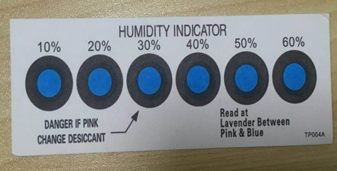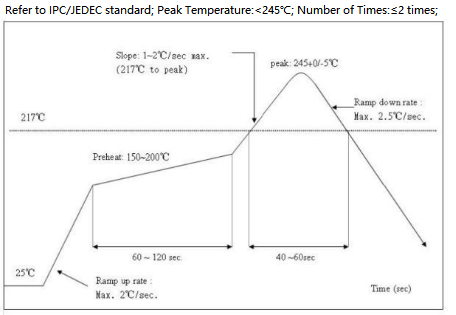
WBLC9 is a low-power embedded Wi-Fi and BLE module that Tuya has developed. It consists of a highly integrated RF chip (BK7231T) and several peripheral components, with an embedded Wi-Fi network protocol stack and robust library functions.
WBLC9 is embedded with a low-power 32-bit microcontroller unit (MCU), 2 MB flash memory, 256 KB static random-access memory (SRAM), and extensive peripherals.
WBLC9 is an RTOS platform that integrates all function libraries of the Wi-Fi MAC and TCP/IP protocols. You can develop embedded Wi-Fi products as required.
| Date | Change description | Version after change |
|---|---|---|
| 2020-4-10 | This is the first release. | V1.0.0 |
WBLC9 has two rows of pins with a 2±0.1 mm pin spacing.
The WBLC9 dimensions (W x L x H ) are 15±0.35mm (W)×16.8±0.35mm (L) ×3.0±0.15mm (H). The figure shows the WBLC9 front and rear views.


| Pin No. | Symbol | I/O type | Function |
|---|---|---|---|
| 1 | P9 | I/O | Hardware PWM pin, which is connected to the P9 |
| 2 | P16 | I/O | Common I/O pin, which is connected to the P16 |
| 3 | P7 | I/O | Hardware PWM pin, which is connected to the P7 |
| 4 | P8 | I/O | Hardware PWM pin, which is connected to the P8 |
| 5 | P26 | I/O | Hardware PWM pin, which is connected to the P26 |
| 6 | VCC | P | Power supply pin (3.3 V) |
| 7 | P24 | I/O | Hardware PWM pin, which is connected to the P24 |
| 8 | GND | P | Ground pin |
| Pin No. | Symbol | I/O type | Function |
|---|---|---|---|
| TP6 | U2_TXD | I/O | UART2_TX, LOG TX |
| TP2 | F_SCK | I/O | Clock pin when data is downloaded from the flash memory, which is connected to the P20 pin on the internal IC |
| TP3 | F_CSN | I/O | Command enabling pin when data is downloaded from the flash memory, which is connected to the P21 pin on the internal IC |
| TP4 | F_SI | I/O | Data input pin when data is downloaded from the flash memory, which is connected to the P22 pin on the internal IC |
| TP5 | F_SO | I/O | Data output pin when data is downloaded from the flash memory, which is connected to the P23 pin on the internal IC |
| TP7 | U2_RXD | I/O | UART2_RX, LOG RX |
| TP8 | U1_TXD | I/O | UART1_TX, User serial port TX |
| TP9 | U1_RXD | I/O | UART1_RX, User serial port RX |
| TP10 | CEN | I | Reset pin, which is connected to 3.3 V for normal use |
| Parameter | Description | Minimum value | Maximum value | Unit |
|---|---|---|---|---|
| Ts | Storage temperature | -40 | 105 | ℃ |
| VBAT | Power supply voltage | 3.0 | 3.6 | V |
| Static electricity voltage (human body model) | TAMB-25℃ | - | 2 | KV |
| Static electricity voltage (machine model) | TAMB-25℃ | - | 0.5 | KV |
| Parameter | Description | Minimum value | Typical value | Maximum value | Unit |
|---|---|---|---|---|---|
| Ta | Working temperature | -40 | - | 105 | ℃ |
| VBAT | Power supply voltage | 3.0 | 3.3 | 3.6 | V |
| VIL | I/O low-level input | -0.3 | - | VCC*0.25 | V |
| VIH | I/O high-level input | VCC*0.75 | - | VCC | V |
| VOL | I/O low-level output | - | - | VCC*0.1 | V |
| VoH | I/O high-level output | VCC*0.8 | - | VCC | V |
| Imax | I/O drive current | - | - | 12 | mA |
| Working status | Mode | Rate | TX Power/ Receiving | Typical value | Maximum value | Unit |
|---|---|---|---|---|---|---|
| TX | 11b | 11Mbps | +17.5dBm | 295 | 354 | mA |
| TX | 11g | 54Mbps | +13.5dBm | 266 | 300 | mA |
| TX | 11n | MCS7 | +13dBm | 260 | 290 | mA |
| RX | 11b | 11Mbps | Constant receiving | 98 | 100 | mA |
| RX | 11g | 54Mbps | Constant receiving | 98 | 100 | mA |
| RX | 11n | MCS7 | Constant receiving | 98 | 100 | mA |
| Working mode | Working status (Ta = 25°C) | Average value | Maximum value | Unit |
|---|---|---|---|---|
| BT | The module is in BT mode, and the Wi-Fi indicator blinks quickly. | 96 | 13 | mA |
| EZ | The module is in EZ mode, and the Wi-Fi indicator blinks quickly. | 134 | 357 | mA |
| AP | The module is in AP mode, and the Wi-Fi indicator blinks slowly. | 178 | 264 | mA |
| Connected | The module is connected to the network and work, and the Wi-Fi indicator is steady on. | 134 | 357 | mA |
| Connected | The module is connected to the network and idle, and the Wi-Fi indicator is steady on. | 153 | 273 | mA |
| Parameter | Description |
|---|---|
| Frequency band | 2.412~2.484GHz |
| Wi-Fi standard | IEEE 802.11b/g/n(channels1-14) |
| Data transmission rate | 11b:1,2,5.5, 11 (Mbps); 11g:6,9,12,18,24,36,48,54(Mbps); 11n: HT20 MCS0~7 |
| Antenna type | Onboard ceramics antenna with a gain of 0.5 dBi |
Performance during constant transmission
| Parameter | Minimum value | Typical value | Maximum value | Unit |
|---|---|---|---|---|
| Average RF output power,802.11b CCK Mode 11M | - | 17.5 | - | dBm |
| Average RF output power,802.11g OFDM Mode 54M | - | 14 | - | dBm |
| Average RF output power,802.11n OFDM Mode MCS7 | - | 12 | - | dBm |
| Frequency error | -10 | - | 10 | ppm |
RX sensitivity
| Parameter | Minimum value | Typical value | Maximum value | Unit |
|---|---|---|---|---|
| PER<8%, RX sensitivity, 802.11b DSSS Mode 11M | - | -85 | - | dBm |
| PER<10%, RX sensitivity, 802.11g OFDM Mode 54M | - | -72 | - | dBm |
| PER<10%, RX sensitivity, 802.11n OFDM Mode MCS7 | - | -68 | - | dBm |
| PER<10%, RX sensitivity, BLE 1M MCS7 | - | -95 | - | dBm |
WBLC9 uses an Onboard ceramics antenna.
To ensure optimal Wi-Fi performance when the Wi-Fi module uses an onboard ceramics antenna.
The PCB dimensions (W x L x H) are 15±0.35mm (W)×16.8±0.35mm (L) ×1.0±0.15mm (H).


WBLC9 module is inserted and welded.
Use an SMT placement machine to mount components to the stamp hole module that Tuya produces within 24 hours after the module is unpacked and the firmware is burned. If not, vacuum pack the module again. Bake the module before mounting components to the module.
Storage conditions for a delivered module are as follows:

Bake a module based on HIC status as follows when you unpack the module package:
Baking settings:
Do not use SMT to process modules that have unpacked for over three months. Electroless nickel immersion gold (ENIG) is used for the PCBs. If the solder pads are exposed to the air for over three months, they will be oxidized severely and dry joints or solder skips may occur. Tuya is not liable for such problems and consequences.
Before SMT placement, take electrostatic discharge (ESD) protective measures.
To reduce the reflow defect rate, draw 10% of the products for visual inspection and AOI before first SMT placement to determine a proper oven temperature and component placement method. Draw 5 to 10 modules every hour from subsequent batches for visual inspection and AOI.
Perform SMT placement based on the following reflow oven temperature curve. The highest temperature is 245°C.
Based on the IPC/JEDEC standard, perform reflow soldering on a module at most twice.

| Product model | MOQ (pcs) | Packing method | Number of modules in each reel Pack | Number of reel packs in each box |
|---|---|---|---|---|
| WBLC9 | 4000 | Carrier tape and reel packing | 1000 | 4 |
FCC Caution: Any changes or modifications not expressly approved by the party responsible for compliance could void the user’s authority to operate this equipment.
This device complies with Part 15 of the FCC Rules. Operation is subject to the following two conditions:
(1) This device may not cause harmful interference, and (2) this device must accept any interference received, including interference that may cause undesired operation.
Note: This equipment has been tested and found to comply with the limits for a Class B digital device, pursuant to part 15 of the FCC Rules. These limits are designed to provide reasonable protection against harmful interference in a residential installation. This equipment generates, uses, and can radiate radio frequency energy and, if not installed and used in accordance with the instructions, may cause harmful interference to radio communications. However, there is no guarantee that interference will not occur in a particular installation. If this equipment does cause harmful interference to radio or television reception, which can be determined by turning the equipment off and on, the user is encouraged to try to correct the interference by one or more of the following measures:
Radiation Exposure Statement
This equipment complies with FCC radiation exposure limits set forth for an uncontrolled rolled environment. This equipment should be installed and operated with a minimum distance of 20cm between the radiator and your body.
Important Note
This radio module must not be installed to co-locate and operating simultaneously with other radios in the host system except in accordance with FCC multi-transmitter product procedures. Additional testing and equipment authorization may be required to operate simultaneously with other radios.
The availability of some specific channels and/or operational frequency bands are country dependent and are firmware programmed at the factory to match the intended destination. The firmware setting is not accessible by the end-user.
The host product manufacturer is responsible for compliance with any other FCC rules that apply to the host not covered by the modular transmitter grant of certification. The final host product still requires Part 15 Subpart B compliance testing with the modular transmitter installed.
The end-user manual shall include all required regulatory information/warning as shown in this manual, including: This product must be installed and operated with a minimum distance of 20 cm between the radiator and user body.
The RF module is considered as a limited modular transmitter according to FCC rules. Even though the RF module gets an FCC ID, the host product manufacturer can not use the FCC ID on the final product directly. In these circumstances, the host product manufacturer integrator will be responsible for re-evaluating the end product (including the transmitter) and obtaining the FCC authorization by a Class II permissive change application or a new application.
Declaration of Conformity European Notice

Hereby, Hangzhou Tuya Information Technology Co., Ltd declares that this module product is in compliance with essential requirements and other relevant provisions of Directive 2014/53/EU,2011/65/EU. A copy of the Declaration of conformity can be found at https://www.tuya.com

This product must not be disposed of as normal household waste, in accordance with the EU directive for waste electrical and electronic equipment (WEEE- 2012/19/EU). Instead, it should be disposed of by returning it to the point of sale, or to a municipal recycling collection point.
The device could be used with a separation distance of 20cm to the human body.